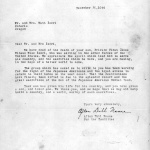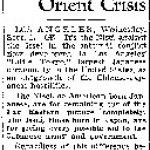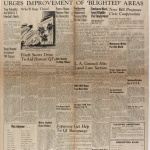Robert Shivers
| Name | Robert L. Shivers |
|---|---|
| Born | 1895 |
| Died | 1950 |
Head of the Federal Bureau of Investigation (FBI) office in Honolulu during World War II. Robert L. Shivers (1895–1950) arrived in Hawai'i on August 23, 1939, to assess the probable loyalty of Japanese aliens and Japanese Americans in the event of war with Japan. He made first-hand acquaintances and generally kept an investigator's open mind. He played a crucial role—it could be argued, the most crucial role—in preventing a massive forced removal and incarceration of Hawai'i's 160,000 people of Japanese ancestry. He also contributed substantially to the mobilization of the 442nd Regimental Combat Team . He became a highly respected figure in Hawai'i. In the postwar, influential Democrats lobbied for his appointment as territorial governor, an idea stopped short by Shivers' declining health.
Shivers was the descendant of a man who walked through the Cumberland Gap and settled in Davidson County, Tennessee, about the time of Daniel Boone. His great grandfather was a slave holder, and his grandfather fought for the Confederacy in the Civil War. Shivers served as an army sergeant in the ordnance supply of artillery during World War I. He was accepted into the FBI in 1923, despite the fact that he had no education beyond high school. During the 1930s Shivers served as a special agent in charge of various key stations around the country, and as such was in direct contact with FBI director J. Edgar Hoover .
Hawai'i and the FBI
Shivers reopened the Honolulu FBI office in the context of a complicated struggle over primary jurisdiction with army and navy intelligence in the areas of potential espionage, sabotage and subversive activity. Intelligence jurisdiction over the overseas territories of the U.S. government, most importantly Hawai'i, were a matter of particular dispute among the intelligence agencies.
Shivers was presented with army and navy lists of names recommended for arrest in the event of war, which he attempted to investigate on a case by case basis. Overwhelmed by the size of the task and a lack of staff, Shivers turned to an analysis of the structure of the community. [1] He cited the University of Hawai'i (UH) regent Charles Hemenway as the most influential force in molding his thinking. [2] Hemenway had devoted much of his life to nurturing UH students and had explicitly denounced racism as a fallacious, self-serving and generally preposterous notion. He was personally acquainted with numerous students and often gathered them at his home.
The Root of Difference
Inspired by Hemenway to believe he could make genuine acquaintances, Shivers set out to organize two community-based groups, one interracial and one made up exclusively of Japanese Americans. Both groups were small, ranging from a half dozen to a dozen people, operating in relative anonymity during the long lead up to the war. The main figures were two men who had overlapped one another on the UH debate team, the loquacious Chinese American YMCA executive Hung Wai Ching and his eloquent "spiritual brother," Shigeo Yoshida , a practitioner of progressive education as defined by the great American intellectual John Dewey.
The Council for Interracial Unity met quietly with dozens of leaders from the broader community. [3] In the summer preceding the war, it staged a patriotic rally of two thousand people at McKinley High School . The head of army intelligence, in the name of the Hawaiian army commander, announced that in the event of war there was to be no mass incarceration, provided that people worked with the constituted authorities and obeyed the law. The concept followed the guidelines enunciated by President Woodrow Wilson in his management of World War I, but they did not reflect conscious policies of either the War Department or President Roosevelt .
Despite jurisdictional conflicts, Shivers consistently dominated intelligence and security issues in Hawai'i. The key feature of his work was community engagement. Shivers asked only for honest and open discussion. This was in contrast to the Office of Naval Intelligence (ONI), which previously had employed a counterespionage model, organizing a network of Nisei who they described in bureaucratic circles as informants. The reality of the ONI initiative was that cooperative Nisei knew nothing about espionage because the espionage for Japan's attack was conducted entirely by Japan's consulate. Coming up empty-handed in informational terms, the navy initiative fizzled, while real authority over intelligence and security remained in the hands of Shivers and the army. [4]
The Justice Department Arrests
At virtually the last moment before the Pearl Harbor bombing, Shivers and army intelligence produced an arrest list of several hundred names, based not on evidence or specific behavior but on an analysis of the Japanese community. The largest number were individuals who helped the widely scattered Japanese-ancestry population with letter-writing and paper work, but their identity was conflated around the words "consular agent." Overlapping categories of those arrested as consular agents included Japanese language school teachers, priests and prominent businessmen with apparent ties to Japan. A small number of the many American citizens who had studied in Japan— Kibei —likewise were arrested. German and Italian aliens also figured in the initial arrests, a small number of whom remained incarcerated for the duration. On December 7 and 8, Shivers oversaw this first wave of arrests in coordination with Army Intelligence and the young Honolulu Police Department officer, John A. Burns .
Martial Law
The Territory of Hawaii was placed under army rule, which clearly was expected by Shivers and other insiders. Martial law suspended constitutional rights and created a rigid system of controls. Arrests were reviewed by hearing boards. This was a feature of nominal fairness that was absent from jurisdictions on the U.S. continent. However, these were crude processes of conversational interrogation that in no way met a standard of American due process. [5] By virtue of army rule, formal jurisdiction over intelligence passed to Army Intelligence, but the Hawaiian army commander gave Shivers the final say on whether a person was incarcerated or released. However, Shivers so thoroughly dominated community perception that, as he once reported to Hoover, most people thought the FBI continued to be in charge.
Although previously diagnosed with heart problems, Shivers worked feverishly. He left his house two minutes after being notified of the Pearl Harbor attack and did not return for ten days.
The issue of a massive forced removal raged continuously—driven by pressure from President Roosevelt and Navy Secretary Frank Knox —for a mass removal. At the same time the army debated the question of whether Nisei should be allowed to serve in the U.S. military.
Shivers was a force in both of these issues. When rumors arose that people of Japanese ancestry had engaged in sabotage on December 7 , Shivers investigated aggressively and quickly. His denunciation of these rumors was immediately accepted in Hawai'i, which did much to create a stable social climate. However, the same rumors spread out of control on the U.S. mainland, despite the efforts of Shivers and others to set the record straight. The result was that the charge of "sabotage"—a complete fabrication—became the leading public rationale for the mass removal and resulting incarceration.
While the removal/incarceration issue was being debated in the West Coast hearings of the congressional committee chaired by Rep. John H. Tolan , eleven different people sent in testimony from Hawai'i denying the sabotage story—all reflecting the position and findings of Shivers. Had federal authorities listened honestly to Hawai'i, there would have been no removal of Nikkei from the West Coast states.
Shivers continued to be a steadying hand in Hawai'i up to and through the early 1943 formation of the 442nd Regimental Combat Team, for which he is credited with playing a contributing role.
Shivers had become a pivotal figure in the Hawai'i home front narrative, which emphasized that over ninety-nine per cent of Hawai'i's Japanese population more or less went about their lives in wartime. Overlooked in this narrative was the way in which the "limited" FBI arrests amounted to a sort of generational coup d'etat, through which the pioneering Japanese Issei leadership was undermined and the Nisei American soldiers—at least those who survived combat—emerged triumphant. Likewise overlooked were the inaccurate characterizations of the "consular agents" and the sweeping prejudicial judgment of the Kibei, many of whom were demonstrably patriotic Americans informed first-hand by the police state of militarized Japan.
Nonetheless the central fact is that Shivers was the central figure in greatly reducing the number of arrests that otherwise would have occurred.
Shivers as Citizen
He reluctantly sought a reassignment in April 1943 after suffering chronic chest pain, departing for light duty on the mainland in a shower of praise. The all-Nisei Emergency Service Committee said it was "largely through the thorough groundwork that you laid before the start of hostilities and your influence and good judgment since then that all the people of Hawaii have been able to enjoy a life of security and freedom." Hoover cited Shivers' work in the prewar as being of utmost importance. The Honolulu Star Bulletin' s Lawrence Nakatsuka wrote, "Robert L. Shivers spoke up for the Nisei with an authority that commanded respect and at a time when his words meant a great deal to the Japanese in Hawaii ... 'Bob' Shivers knew the Nisei as perhaps no other non-Nisei knew them ... because 'Bob' Shivers knew exactly what to do, Hawaii's Japanese population was given the golden chance to vindicate the faith he had in their trustworthiness..." [6]
Some of the testimony for Shivers was intensely personal. Shigeo Yoshida described Shivers as not only a valued leader but a personal counselor, as did Mitsuyuki Kido, the staff secretary of the Emergency Service Committee. Perhaps Shivers' most important relationship was with Sue Isonaga, who was taken in as a student boarder by Shivers and his wife, Corrine, on their arrival. Often in the evening after work, Shivers talked with Sue at great length about growing up as a Japanese American. He and Mrs. Shivers soon referred to her as their adopted daughter and maintained close relationships with her throughout their lives. Shivers told her that he could not stand the thought of her being interned, or thousands of others who he imagined to have her good qualities.
In 1944, craving a return to Hawai'i, Shivers sought a presidential appointment as collector of U.S. customs. Yoshida and others "passed the hat" to pay Ching’s travel expenses to Washington D.C. On arrival Ching telephoned the First Lady, Eleanor Roosevelt , with whom he had become acquainted in the course of his advocacy for Japanese Americans. She promptly called Secretary of the Treasury Henry Morgenthau, who made the appointment.
In the postwar, as the Democratic Party began its rise in Hawai'i and as support built for statehood, Shivers was prominently discussed for appointment as governor of the territory. Burns was by this time the party chairman and spent two months in Washington D.C. lobbying for Shivers. However, Shivers' health declined further. He died in 1950 at the age of 56. He is buried in Diamond Head Memorial Cemetery and his grave is tended, to this day, by his "adopted daughter," Mrs. Isonaga.
For More Information
Coffman, Tom. The Island Edge of America: A Political History of Hawai'i . Honolulu: University of Hawai'i Press, 2003.
Odo, Franklin S. No Sword to Bury: Japanese Americans in Hawai'i during World War II . Philadelphia: Temple University Press, 2003.
The First Battle: The Battle for Equality in War-Time Hawaii . Documentary film written, produced and directed by Tom Coffman, 2006. 56 minutes.
Footnotes
- ↑ Shivers to Hoover, May 14, 1943; author's file, courtesy of Sue Isonaga.
- ↑ Shivers to Hemenway, Oct 10, 1943; author's file, courtesy of Sue Isonaga.
- ↑ The most extensive description of the interracial unity effort was that of Shigeo Yoshida, who quickly wrote a three-page narrative for the martial law government in the transition to wartime. Many others partially described it or alluded to it, including Shivers.
- ↑ The clearest description of the 'navy's large circle of Nisei is, to my knowledge, that of Lt. William B. Stephenson, given to the Hewitt investigation of the Pearl Harbor attack. Stephenson was a Honolulu attorney and navy reservist who was activated to service prior to the war. Stephenson was in charge of what was known as the Japanese counterintelligence desk at Pearl Harbor. The eccentric naval intelligence officer Cecil Coggins also described this network and others alluded to it.
- ↑ I have read several transcripts of hearing boards. Each came down to rhetorical questioning in which the subject person was prompted to say that he supported America in the war and vehemently wished for Japan's total humiliation and defeat. A compulsion for honesty, or honor, led respondents to cite their citizenship in Japan and their lifelong exclusion from naturalized citizenship in America, resulting in a hope that the war would simply be over quickly, as if it were a bad dream. These transcripts should be studied. I have read numerous police reports of profiling or heavy-handed counseling in which much the same dynamic went on.
- ↑ Lawrence Nakatsuka, Honolulu Star Bulletin , June 30 1950, p 2.
Last updated Jan. 16, 2024, 1:02 a.m..








